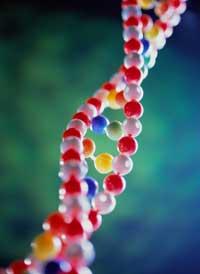Less and less secret genomes
What we do not understand is not necessarily useless: sometimes, as we move forward in work, unexpected discoveries emerge. This has happened to scientists studying the human genome: since the first draft of the human genome spread to the four winds, errors and ignorance have been evident.
But not everything is gray, and many genome data are absolutely safe. For example, most school books teach that DNA is in the nucleus of the cell and forms X-shaped structures rolled over itself: chromosomes. In these chromosomes, DNA is organized, just as the books of a library are arranged on the shelves.

It is also known that each chromosome contains accurate information, but from there the darkness begins to predominate, since not all that information is still understood or well known. Of course, it is clear that DNA is divided into two parts: that which contains useful information and that which is useless. The first part consists of the genes that store the codes to form proteins and the second part of the DNA
remains.
No value
The non-coding part has been called garbage:
DNA garbage. All parts of the unknown DNA are thus called. But it is worrying: at least half of the genome enters that part. What does that mean? That half of the genome is useless? Why then do we have all this information stored in the cells? There are explanations for this.
According to biochemists, the explanation is in the footsteps of evolution. There have remained the genes of our ancestors, some totally outdated; and of our ancestors; and their ancestors, etc. Keep in mind that this regression reaches the bacteria, which have also left us fragments of genes dispersed by the genome. No wonder there are remnants of so many years of evolution in the genome.
However, it is no wonder that science cannot yet explain things. A part of the DNA is called garbage, but it may work for something. From this idea, several lines of research have been opened, of which the results have been published in the latest issue of the specialized journal Nature Genetics.
Repairer

The research that has just been published focuses on the elements called LINE-1, which are represented with the abbreviation L1. They represent 17% of the total of our genome, but however, very little research has been done on this large part. Now, some American biochemists have found a special capacity for L1 elements: they retouch broken DNA chains, that is, they act as repairers. This ability has modified the idea of these parts of DNA.
Until now, scientists considered that the L1 elements behaved like parasites. They have the ability to break DNA chains and interlace them anywhere. There was a lot of talk, because after all, viruses also use such a strategy. But with what has now been discovered, the idea of the parasite is turned upside down: L1 elements can jump from chromosome to chromosome to find and repair damaged chains. That is why perhaps that piece of DNA that was useless is essential for the cell.
Many fragments of the genome remain strange, so researchers should explore new pathways. This time it
seems that they have found a repairing element in the form of a parasite. That's important, but perhaps it's more important to recognize that we lack much.
Buletina
Bidali zure helbide elektronikoa eta jaso asteroko buletina zure sarrera-ontzian











